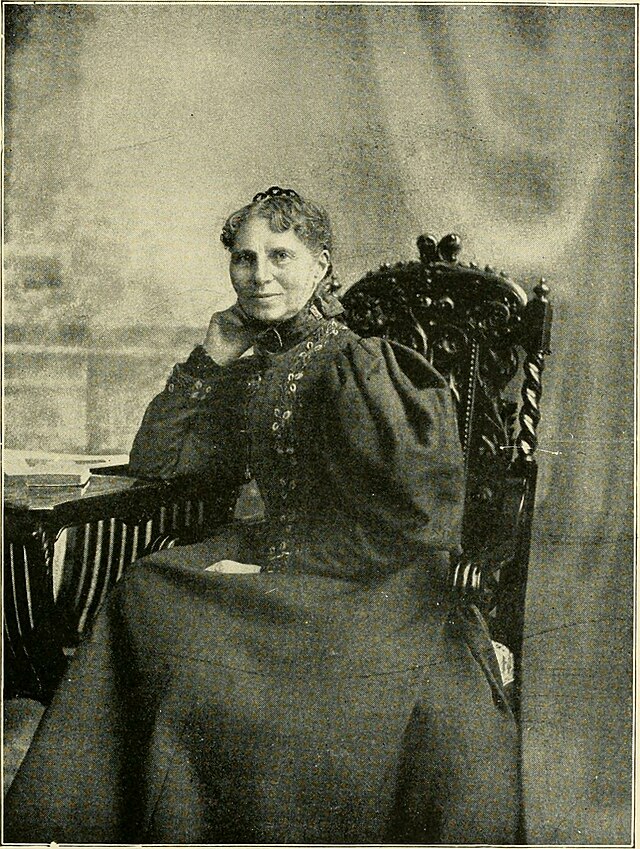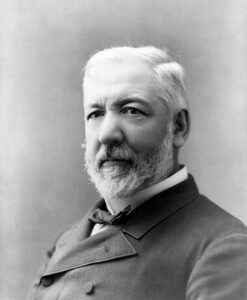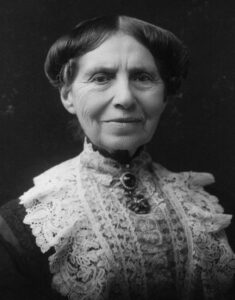March 21, 2024
Clara Barton: Mother of the American Red Cross

Determination and hope were the two champions of Clara Barton’s spirit throughout her mission to establish the American Red Cross. Having served as a nurse on the frontlines during the American Civil War, Barton witnessed the horrors and devastation that always accompany such carnage in a way that many Washington officials had not experienced. Barton’s perspective of the war ignited a flame within her to find or create something new to help those suffering in a more organized and meaningful way. However, she found herself lost as to where to begin her search for such a solution. That all changed with her trip to Europe in 1868.1
While in Europe, Barton was exposed to many new and beautiful wonders that had not yet crossed the Atlantic to the United States. Out of all the wonders the great continent had to offer, one in particular called to her in a way that would forever change her life: the International Red Cross. Unlike anything else of its time, this organization would go out into various regions of the world that were experiencing various types of crises—both human-made and natural disasters alike—to help those in need by providing numerous kinds of aid. This is what Clara Barton had been searching for, and this was exactly what she planned to bring home with her when she returned to America.2
After returning from her European voyage, Barton got straight to work. She first wrote to Louis Appia, one of the several founders of the International Red Cross, asking for permission to start an American branch of the great organization. Appia granted Barton her noble request to pursue her dream, but added that she would first need to get the Treaty of Geneva ratified by the United States before an American Red Cross could ever be established.3 The treaty stated that in times of international crisis and war, medical professionals were to be given the ability to help any injured soldier, regardless of who they fought for, and provide these doctors and nurses with protection by requiring them to wear a white armband with a red cross on it to signify that these individuals were not to be intentionally harmed. This posed a great challenge, as the United States had chosen to stay neutral in many global affairs to the best of its ability, and it was still working to rebuild and reunite itself after the atrocious Civil War. Despite these obstacles, Barton accepted the task and set her sights on Washington D.C. She knew that in order to achieve her goal, she would first have to gather support from those in the capital.
In 1878, soon after she had officially moved to Washington D.C., Clara Barton had a meeting with President Rutherford B. Hayes and his wife Lucy to discuss both the ratification of the Treaty of Geneva and the formation of an American branch of the Red Cross. For Clara, the meeting showed great promise and gave her the impression that, with the support of both the president and the first lady behind her, her goals were as good as reached. President Hayes arranged for Barton to meet with Secretary of State William Evarts to discuss the terms of the treaty and its ratification process. Despite Barton seemingly having the support of the White House behind her, Secretary Evarts refused to meet with her and had her sent away without ever hearing her out. Having been both angered and offended by the secretary’s actions, Barton realized that she needed to change her tactics in order to succeed in the ratification of the Treaty of Geneva. She realized that instead of starting at the top of the political chain with the president and his cabinet, she needed rather to start by forming a strong base built on support from her friends.4
Despite being a woman in the late nineteenth century, Clara Barton made a bold impression on the political elites of Washington. With the help of friends she had made while serving in the Civil War, Barton began to expand her campaign for ratification. She first connected with senators and congressmen through her friend John Hitz, and persuaded many of them that an American Red Cross was necessary in a growing nation like the one they called home, and that without the ratification of the Treaty of Geneva, it simply would not be possible. Having planted the seeds to start gaining support from Congress, Barton turned her attention to other sectors of the government in hopes of similar success. However, she was once again met with opposition and rejection. After what felt like failure after failure in the capitol, Clara Barton decided to take a break from her campaign, and returned home.5

After five months of stepping back to rest and regain her strength, Clara Barton emerged once more onto the scene by publishing her pamphlet “The Red Cross of the Geneva Convention: What it is” in 1878.6 This pamphlet, which focused on promoting both wartime responsibilities and disaster relief, was used to promote the Red Cross to the public more than to politicians. With this new approach, Barton also found herself befriending new individuals who were sentimental to her cause, such as Dr. Julian Hubb, as well as journalists Walter Phillips and George Kennan.7 These men helped advocate for Barton’s cause and gathered many new supporters. Through these new campaigning outlets, Barton was able to reach one of her greatest allies in the fight for ratification and the American Red Cross: veterans. Clara Barton shared a deep relationship with many Civil War veterans, having been with them and having cared for them in their darkest hours not so long ago. These men had a deep respect for Barton and all that she stood for. Feeling in debt to her for having saved their lives on the battlefield, these men and their families supported her in her endeavor to create the American Red Cross.8 The rallying support from the veterans empowered Barton and inspired her to enter the world of politics once again. She began by offering her support, as well as that of her fellow advocates, to James A. Garfield in the Presidential Election of 1880 in hopes that if he won, he would in turn support her efforts for the ratification of the Treaty of Geneva. It was at this moment that Clara Barton finally began to see light shine down upon her and her noble efforts in forming the American Red Cross Organization.
Garfield did indeed win the election, and soon after his inauguration, he met with Clara to discuss her proposal for starting an American Red Cross, and more importantly, for ratifying the Treaty of Geneva. Similar to his predecessor Hayes, while supporting her in her endeavors, Garfield also thought it best that Barton discuss her propositions with his Secretary of State, James Blaine. When she arrived at the designated office, Clara desperately hoped for a different outcome from the one she experienced in 1878, and therefore took a different approach by bringing her nephew with her. In the end, Secretary Blaine applauded Barton for her hard work and offered his full support in pushing for the ratification of the treaty. With his backing, Barton received an influx of supporters once more, this time from political figures such as Robert Lincoln and William Windham, other members of Garfield’s Cabinet. With great government acceptance finally coming in, Gustave Moynier renewed the request for the United States to sign the Treaty of Geneva, to which Blaine responded in kind by affirming the intention of the American government to sign the treaty. Blaine was greatly excited by this development, as he wanted to change foreign policy in the United States and shift away from a place of isolationism to joining a world of collaboration and integration. Barton was equally, if not more, excited for the developments, as she had devoted the last several years of her life to the ratification and was finally seeing real success. In anticipation of the ratification of the Treaty of Geneva, Barton held the first American Red Cross meeting on May 12, 1881. She officially founded the organization soon thereafter, on May 21, 1881. With things finally looking up, there was nothing that could rain on Clara Barton’s parade. That is, until the assassination of President James A. Garfield on July 2, 1881.9

While President Garfield did not die immediately, he did pass away soon after the assassination on September 19, 1881, before the Treaty of Geneva could be ratified.10 This left both Barton and Secretary Blaine unsure of the future they had been working so hard to achieve and had almost grasped into reality. With Chester A. Arthur next in line for the role of president, the fate of the ratification was left unknown, as neither party knew where Arthur stood on the subject. The coming of a new president also meant a new cabinet, meaning that Blaine might only hold his position through December. If Barton and Blaine wanted to see the Treaty of Geneva ratified, they would have to work fast, as they were running out of time.
As one problem came along for Clara Barton, another soon appeared. Secretary Blaine was working quickly to push the ratification of the treaty before the end of his short term at the end of the year; however, he struggled to determine which specific documents needed to be ratified and signed. Since the time of Clara Barton’s original request for ratification, several amendments had been made to the original treaty, leaving Blaine confused as to whether the original version he was provided should be ratified or the newly amended version, which would have taken longer to convince Congress to approve. Lost and confused, Barton wrote to Moynier for clarification. Once she received his answer that the original document would suffice, Blaine got right back to work with Barton’s help.11
In what seemed to be the darkest hour for Clara Barton, with her strongest ally Secretary Blaine about to be dismissed from his position, and with the Treaty of Geneva still having not been ratified, a light shone down upon her. In December 1881, President Arthur addressed Congress, giving his full support for the ratification of the Treaty of Geneva, and finally, on March 16, 1882, the treaty was officially ratified and signed. Clara Barton’s newly founded American Red Cross was now protected under the treaty, allowing for Barton’s true mission to begin.12
The organization began its work by assisting with natural disasters, such as wildfires, and hurricanes, and provided aid to those suffering in territories ridden with war.13 As the American Red Cross continued to grow into a larger and more established organization, Clara Barton found a new goal of obtaining government funding for these sanctioned projects. She went on to achieve this goal, just as she had succeeded in forming the American branch of the Red Cross in the first place. For her determination and perseverance, Clara Barton was named president of her branch and remained so for twenty years. She is a hero and a role model to all who serve and fight for dignity and human rights, as this is what she fought fiercely to promote and protect through the birth of the American Red Cross.

- Elizabeth Brown Pryor, Clara Barton, Professional Angel (University of Pennsylvania Press, 1987), 154. ↵
- Marian Moser Jones, The American Red Cross from Clara Barton to the New Deal (Baltimore: Johns Hopkins University Press, 2013), 26. ↵
- Elizabeth Brown Pryor, Clara Barton, Professional Angel (University of Pennsylvania Press, 1987), 188. ↵
- David H. Burton, Clara Barton: In the Service of Humanity, in Contributions in Women’s Studies, no. 148 (Westport, Conn: Greenwood Press, 1995), 85-88. ↵
- Elizabeth Brown Pryor, Clara Barton, Professional Angel (University of Pennsylvania Press, 1987), 193. ↵
- Elizabeth Brown Pryor, Clara Barton, Professional Angel (University of Pennsylvania Press, 1987), 195. ↵
- David H. Burton, Clara Barton: In the Service of Humanity, in Contributions in Women’s Studies, no. 148 (Westport, Conn: Greenwood Press, 1995), 90. ↵
- Fred R. van Hartesveldt, “Clara Barton.,” in Salem Press Biographical Encyclopedia (Salem Press, April 30, 2023). ↵
- Marian Moser Jones, The American Red Cross from Clara Barton to the New Deal (Baltimore: Johns Hopkins University Press, 2013), 33-35. ↵
- William E. Barton, “The Life of Clara Barton, Founder of the American Red Cross / by William E. Barton.,” January 1, 1922, 160. ↵
- Elizabeth Brown Pryor, Clara Barton, Professional Angel (University of Pennsylvania Press, 1987), 204. ↵
- Marian Moser Jones, The American Red Cross from Clara Barton to the New Deal (Baltimore: Johns Hopkins University Press, 2013), 35. ↵
- Luis Granados, “Finding Clara Barton.,” Humanist 78, no. 2 (March 1, 2018), 35. ↵
Tags from the story
Nomination-American-Studies
Nomination-Descriptive
Recent Comments
Leaya Valdez
Knowing the history of American Red Cross is very interesting and even hearing Clara Barton story and why she started this organization. She undoubtedly had and has made a huge impact and contribute to America. The history of Clara Barton and American Red Cross should be recognized and shouldn’t be taken for granted because Barton created one of the most important organizations in American history. Amazing article and great way to shed light on Clara Barton.
26/04/2024
7:49 am
jhollowell
I enjoyed this piece, as I love Clara Barton’s story and this article truly does capture her determination and perseverance to establish the American Red Cross. I especially liked the way the author shows Barton’s struggles and hardships that she faced as well as her achievements. I also enjoyed the use of direct quotes and vivid description of how she got to her groundbreaking accomplishments.
26/04/2024
7:49 am
Martin Martinez
This does well to highlight the struggle for apolitical medical assistance after the Civil War. It’s so surprising that so much change was enacted by a woman in the 1800’s, when they were so underrepresented and underestimated on a social level. This is also a reasonable guide on how to fight for programs; Barton’s change of strategy is something people might employ.
26/04/2024
7:49 am
Nicholas Pigott
Hi Eliana! Your article is a fantastic background story into one of the most important organizations in America. I doubt this story is one that even few Americans know, and you did an amazing job at bringing that story to light. We have Clara Barton to thank for all the good that the Red Cross has done for America. Congratulations on your nomination!
29/04/2024
7:49 am
Sebastian Hernandez-Soihit
Your article about Clara Barton beautifully captures her unwavering determination and resilience in establishing the American Red Cross. Very good narrative structure that hooks the reader with high and lows of her journey, and I appreciate that the narrative effectively highlights Barton’s strategic approach, and her ability to garner support, and the significance of her efforts in shaping humanitarian aid. It’s a compelling tribute to Barton’s legacy as a champion of compassion and service to humanity.
29/04/2024
7:49 am
Maria Fernanda Guerrero
Oh wow Clara Barton had quite an intensive journey trying to get the Geneva treaty ratified. You expressed yourself beautifully Through your writing I was able to feel Barton stress and pressure and at the end the great relief. Barton never gave up. She showed great persistence and determination. It’s true what they say, we can do anything we want only, the question is how bad do you want it? I digress, amazing article and bravo on how you executed it!
29/04/2024
7:49 am
Fernando Milian
It’s amazing to see how Clara Barton turned her experiences in the Civil War into a lifelong mission to help others. I think it is super brave how she did not just accept the situation but instead looked for solutions, even if it meant traveling across the ocean to find them. Her determination to get the Treaty of Geneva ratified, despite the many setbacks, really speaks volumes about her character. Plus, it is pretty inspiring how she managed to rally support from different people, including veterans who really believed in her because of her past efforts to help them. Clara Barton’s story definitely makes me think about how one person can make a huge difference with enough passion and persistence.
02/05/2024
7:49 am
Lauren Sahadi
We all know the American Red Cross, but I didn’t know how it was established. Clara Barton established the American Red Cross and it was a very inspiration story. Clara faced many challenges and setbacks, but her perseverance let to her accomplishments. This was a very inspirational story and article. I like that you chose the story about something that is commonly known. Great article.
04/05/2024
7:49 am
Carlos Anthony Alonzo
Your research adds a crucial dimension to our understanding of Clara Barton’s story, offering fresh insights that enrich the scholarly discourse. Your article’s attention to detail only strengthens the validity of Clara Barton’s story, setting a high standard for future articles for St. Mary’s University. Well done!
05/05/2024
7:49 am
Deven Garcia
The history of the American Red Cross is truly remarkable. Exploring Clara Barton’s challenges and unwavering perseverance was enlightening and inspiring, as it paved the way for the organization’s unparalleled humanitarian efforts in disaster relief and war-torn regions.
26/04/2024
7:49 am